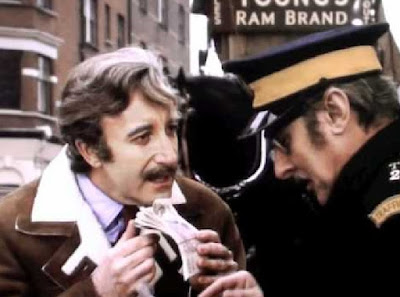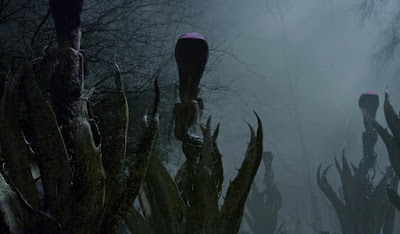Wednesday, December 1, 2021
Whispers of Fear
Monday, November 1, 2021
Tree of the Living Dead
Friday, October 1, 2021
Angel With Attitude
Wednesday, September 1, 2021
Séance and Sensibility
Abramelin and its demand for intricate, long-term preparation is credited to 14th-century Egyptian magician Abra-Melin, and plays out like a binding contract. In 1897, The Book of the Sacred Magic of Abramelin the Mage was translated into English by British occultist Samuel L. MacGregor Mathers, and was highly influential in the Hermetic Order of the Golden Dawn. Aleister Crowley - at the time a young member - started preparations for seeking the angel in Boleskine House, but abandoned this plan during the Hermetic Order division of 1901. The one thing that Mathers, Crowley and, indeed, most occultists, take from Abramelin is the existence of a benevolent demigod; consequently, a master or supreme magus can feed any number of charismatic and egotistical myth-makers.
Sunday, August 1, 2021
Ghost Breakers
It was during his time as story editor on ALFRED HITCHCOCK PRESENTS that director Gordon Hessler discovered the film's source novel by Jay Bennett. An adaptation was rejected for the show, but became his theatrical directorial debut. Yet CATACOMBS cannot shake off its feel of an extended anthology episode; Merrill - himself a veteran of Hitchcock's TV programme - is perfectly cast as the aging gigolo, and Cookson is frightening and glacially fragile (when Raymond carries his wife in his arms, Ellen seems to eerily transform into a mannikin). The tension is simple but effective (the sound of Ellen's walking cane, the moving of locked door knobs), and although the double twist ending will not surprise all, it nevertheless is a satisfying climax to a well made and entertaining thriller.
 Shot at an old psychiatric hospital near Uxbridge, DARK PLACES was the only release from Glenbeigh/Sedgled, but it had a great poster.
Shot at an old psychiatric hospital near Uxbridge, DARK PLACES was the only release from Glenbeigh/Sedgled, but it had a great poster. Helmed by Don Sharp, DARK PLACES is a pedestrian haunted house/psychological thriller that is also rarely discussed at length. Following the death of an aging asylum inmate, Edward Foster (Robert Hardy) inherits an old mansion with a grim reputation: a woman, the housekeeper and two children have disappeared without trace. However Edward is more interested in the £210,000 hidden somewhere behind the walls. Unfortunately there are others who also want the money: Dr Ian Mandeville (Christopher Lee) and his sister Sarah (Joan Collins), together with solicitor Mr Prescott (Herbert Lom). With Sarah helping Edward at the mansion, and the siblings faking paranormal occurrences, the building and its backstory start to affect Foster's fragile psyche. Possessed by the spirits of the deceased, he begins his own murder spree.
Similar to the feel of CATACOMBS, DARK PLACES plays more like a TV movie, hampered by uncharismatic direction and photography. Hardy has a lot of character aspects to grapple with and manages to just about carry the film, while the all-star cast are wasted (although Collins inevitably shines as the sexually conniving sleuth). Even the flashback sequences have quality performers in small roles, with Jean Marsh and Jane Birkin. The notion of the Mandeville fake haunting is never developed; in fact, the realisation that strange things are actually happening is only met with brief puzzlement. It's a shame, as this interesting trope dates back to earlier stories such as THE CAT AND THE CANARY and THE GHOST BREAKERS, particularly in the context of money and induced madness.
Thursday, July 1, 2021
The Cat Creeps
The all-star cast give performances that could generously be described as unconventional, portrayals of people who are all killers one way or another: disgraced doctor Henry (Daniel Massey, whose father Raymond had spent a night at James Whale's THE OLD DARK HOUSE), big game hunter Susan (Honor Blackman) and her lesbian lover Cicily (Olivia Hussey), who shot an employer attempting to rape her, war hero Charlie (Peter McEnery) and songwriter Paul (Michael Callan), obliquely "the biggest killer of all" according to West. It's a hodgepodge of goofiness undermined by strange lapses: why is Cyrus' formalities in sound, for example, and the two climatic shootings are completely bloodless.
Tuesday, June 1, 2021
Black Smoke and Red Dust
PETER Harness' three-part BBC adaptation of H.G. Wells' seminal invasion novel is not only the first British television stab at the story, but one that follows a female lead. Even before the Martians arrive, Amy (Eleanor Tomlinson) and partner George (Rafe Spall) have problems. In quite the Edwardian scandal, George has left his wife/cousin for the younger Amy, which has caused friction with his politician brother Frederick (Rupert Graves). Denied a divorce, Amy announces she is expecting George's baby. It seems their only friends are sprightly astronomer Ogilvy (Robert Carlyle) and maid Mary (Freya Allan), although the latter is killed under a pile of rubble during the first wave of attacks.
Wells' narrator hero is described as a "professed and recognised writer on philosophical themes," yet here George is a Woking journalist and superficial wet fish, branded a coward by his ex-wife and failing to help a dying soldier. The flash forward/back structure of the leading players separation denies any workable screen time for Amy and George, which is probably for the best, as when they do share scenes Tomlinson and Spall's chemistry is insipid (Spall seems under varying levels of sedation). Thankfully this is Amy's tale, providing much needed ballast in what is more than just an angle on our current fixation with political correctness; unlike most female evaluations of major franchises, the character is intelligent and driven in complex, emotional situations.
The main allegory of Wells' novel - decaying imperialism - is illustrated by Amy having been raised in the British Raj, and the jingoistic comments of the military and politicians. "It seems that something has arrived in England" announces Chamberlain (Nicholas Le Prevost), a battle cry that today can be viewed as xenophobia. Initially planned to screen over the 2018 festive season, it would have been particularly hard for the masses to swallow such a slow, doom-laden miniseries; the death and devastation is shrouded in war machine black smoke and wasteland red hues, highlighting another interpretation of the narrative: climate change. In fact The War of the Worlds has always portrayed a foreboding and prophetic end of days template: Orson Welles' radio broadcast occurred during the escalation of Nazi Germany, George Pal's 1953 film was released at the start of the Cold War, and Steven Spielberg, following his 2005 big screen take, said that "after 9/11 [the book] began to make more sense to me."
Saturday, May 1, 2021
Come and Get It
Thursday, April 1, 2021
Beware the Triffids
Monday, March 1, 2021
We Are for the Dark
Monday, February 1, 2021
School of Shadows
MOST British sex comedies are unsexy and unfunny, but Pete Walker's SCHOOL FOR SEX - sold on its title alone - is also terminally boring. After the sudden death of his parents, bounder Giles Wingate (Derek Aylward) - on a suspended sentence for embezzlement - inherits a country estate. Yet his wealth is soon diminished by a series of gold-digging wives, leading him to take revenge: setting up a "school for sex" which trains young female offenders to fleece money from millionaires for a third of the profit. Wingate converts his house for the venture and employs ex-boxer Hector (Nosher Powell) and dipsomaniac Duchess of Burwash (Rose Alba) as staff; with a steady flow of girls from a corrupt probation service, anti vice campaigners finally lead Wingate back to court.
Similar to COME PLAY WITH ME, SCHOOL FOR SEX was a triumph of marketing, hiding the embarrassment underneath. One of Walker's biggest box office successes, the film was particularly popular in the United States and France, where punters - high on the sexual revolution - were duped with fake promises of underage sex even in the more risqué export version (in fact, American success is enshrined: during the opening of SHAFT, when Richard Roundtree strides down 42nd Street, he passes the Rialto Cinema advertising "first New York show, SCHOOL FOR SEX.") Yet, while Walker draws on the permissive age, the result is a regressive opposite; we are still in the realm of the stereotypical British farce, pigeon-holing carnal urges like a pre-war sex tussle.
Friday, January 1, 2021
Time Warp Terror
 Welcome to the Grand Island Hotel, where FIEND WITHOUT A FACE plays at the theatre, a magazine proclaims Michael Landis was in I WAS A TEENAGE WEREWOLF, and the music is by Cry No More.
Welcome to the Grand Island Hotel, where FIEND WITHOUT A FACE plays at the theatre, a magazine proclaims Michael Landis was in I WAS A TEENAGE WEREWOLF, and the music is by Cry No More.THE horror film output of Norman J. Warren was cheaply derivative and mundanely surreal. Starting when both Hammer and Amicus were already past their death throes, Warren's take on SUSPIRIA created the surprise hit TERROR, a catalogue of genre cliches and Dario Argento-inspired sequences which basically views as a highlights package. Yet this is nothing compared to BLOODY NEW YEAR, a dire patchwork in which the filmmaker fully subscribes to Argentoesque nonsensical plotlines and riffs on a number of other hits (A NIGHTMARE ON ELM STREET and the demonic cacklings of THE EVIL DEAD in particular).
High in concept but very low in budget, an aircraft carrying a Government-funded experiment crashes on an island, causing a time displacement permanently fixed between 1959 and 1960. American Carol (Catherine Roman) is visiting England and killing time by being harassed by some hoodlums at a funfair. Rescued by five strangers, the group go sailing in a boat owned by Rick (Mark Powley), but run into trouble when tiresome lothario Spud (Colin Heywood) steers them onto rocks. The gang wade ashore and discover the Grand Island Hotel (actually Butlins Barry Island), which appears deserted and festively decorated even though it is July. With a disappearing chambermaid and only fifties-style party clothes found in the rooms, the visitors are soon entangled in more bizarre events.

























